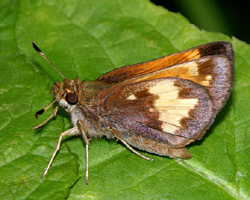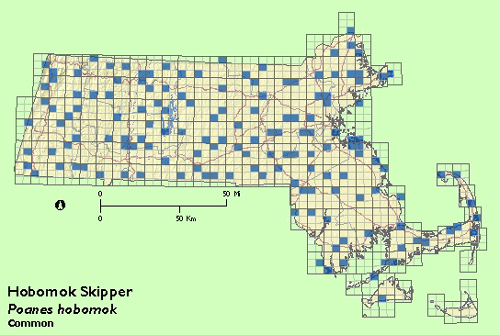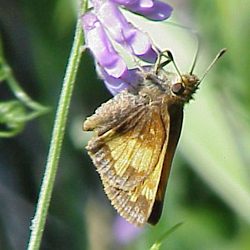Find a Butterfly
Hobomok Skipper
Poanes hobomok
Named
Harris, 1862

Identification
Wingspan: 1 to 1 and 3/8". This medium-sized orange and black skipper is best recognized by the broad yellow ("golden") band or patch on the undersurface of the hindwing. While these markings are superficially similar to those on Peck‘s Skipper (Polites peckius), the Hobomok Skipper is a notably larger butterfly and the under hindwing markings form one solid band (see Peck‘s Skipper, "Identification").
As with many skippers there is also a dark, female form (pocahontas). These individuals are overall dark brown with a few small, white markings on the forewings. Both the predominant light form as well as the dark morph often display a distinct violet tint to the outer edge of the hindwings below.
See also Zabulon Skipper (Poanes zabulon) which occurs rarely in Massachusetts.
Distribution
Central Alberta east to Nova Scotia; northeastern Colorado east through central New Jersey and south along the Appalachians into northern Georgia. Throughout New England.
Status in Massachusetts
Hobomok Skipper is a common butterfly throughout most of the state. While there are no recent records for Nantucket, historical accounts indicate that this species once occurred on that island. Maximum: 18 on 8 June 1991, Mt. Greylock (Berkshire Co.).

Flight Period in Massachusetts
One flight: late May through early July. Extreme dates: 17 May 1991, Milford (Worcester Co.), T. Dodd and 15 July 1988, Tolland (Hampden Co.), E. Dunbar.
Larval Food Plants
Grasses including panic grasses (Panicum, spp.) and blue grass (Poa).
Adult Food sources
Found nectaring on nearly a dozen different species by atlas workers including Red Clover, Cow Vetch, and blackberry.

Habitat
Woodland edges, paths, and openings; also second growth fields and gardens with a ready supply of nectaring sources.
Life Cycle
EGG: Pale green; dome-shaped. OVIPOSITION: Eggs laid singly on or near grasses. LARVA: Brown or dark green with numerous black spines. CHRYSALIS: Reddish, mottled with brown. Scudder says "of uniform livid hue" perhaps referring to P. zabulon. OVERWINTERING STAGE: As both larva and chrysalis.
Adults are regularly found on shrubby perches. Hobomok Skippers are strong fliers and move rapidly when startled.
Account Author
Richard K. Walton



